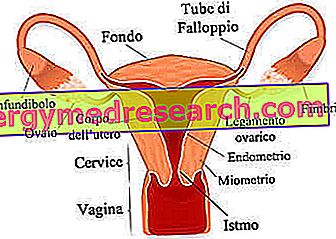Generality
The famous " mumps ", which affect many children during childhood and early adolescence, are more correctly defined by the term mumps . It is an infectious disease, acute and contagious, of viral origin.

Mumps occurs more frequently in children and adolescents; it is less frequent among adults, in whom it has a more severe course with greater frequency of complications.
Incidence and Contagion
Mumps is widespread throughout the world, with greater incidence at the beginning of spring. Periodically (every 2-5 years) re-ignitions occur, particularly in restricted communities (kindergartens, schools, hospitals). Infection is rarely contracted before 2 years of age and affects young adults more frequently. Transmission occurs by direct contact, with saliva and respiratory droplets (called Flügge droplets), and more rarely through objects contaminated with the same droplets. The mumps virus is eliminated with saliva and urine and is present in secretions from 7 days before to 2 weeks after the appearance of the swelling of the parotid gland; the maximum peak of contagiousness lasts a few days. The infection, even asymptomatic, gives lasting protection from new infections, but does not exclude the rare possibility of reinfection in adults.
Mumps Symptoms
To learn more: Mumps Symptoms
Mumps is caused by a spherical virus ( paramyxovirus ) that is found, in the sick subject, in his saliva, urine, breast milk and blood. The entrance door of the virus is the respiratory mucosa, where it multiplies and then invades the cervical lymph nodes (of the neck) and the salivary glands. The incubation period lasts about 2-3 weeks: it is generally asymptomatic, although it can sometimes be accompanied by malaise, anorexia (loss of appetite), shiver, low-grade fever. Instead, the onset of mumps is acute, with fever, otalgia (pain in the inner ear), myalgia (muscle pain), headache and swelling of the parotids, without superficial signs of inflammation: they appear painful, difficult to delimit and of hard consistency and elastic.
The involvement is initially unilateral (from one side only), but in most cases (75%), the contralateral parotid is also involved in about 2 days. Other salivary glands, such as submandibular and sublingual, may also be affected.
The increase in the volume of the parotids lasts for 2-3 days, giving the patient a particular facies (appearance of the face) (whence the particular name of mumps) due to the forward and outward movement of the auricles.
In about a week, the glands return to normal size.
The acute phase of epidemic mumps is characterized by spontaneous pain in the parotid gland sites, which is accentuated with chewing, acid food intake and palpation; within the oral cavity, the reddening and swelling of the excretory duct of the glands are often highlighted, through which saliva is introduced into the mouth, which may appear surrounded by small hemorrhages.
Fever, usually around 38-40 ° C, persists for 4-5 days, then resolves, simultaneously with the alleviation of pain and general symptoms.
There may also be extrasalivary localizations of the virus, and they can occur at any stage of the disease, mainly after parotid involvement. The other organs most interested are:
- The testicles, in which we can have an orchiepididimite (an inflammation of the epididymis). It occurs in 20-30% of males after puberty and is bilateral in one of the six cases. It is characterized by swelling and pain in the scrotum, nausea, vomiting, fever. This complication of mumps is usually benign and regresses within 5-7 days. Sometimes, in a small percentage of cases, it can cause sterility.
2. The pancreas, with pancreatitis, although in a small number of cases. Sometimes the picture can be confused with an appendicitis, or be limited to the appearance of abdominal pain, nausea, vomiting, constipation or diarrhea. The usual outcome is healing in a few days, serious complications are rare, while the possibility that the infection favors the onset of diabetes is not ruled out.
- The involvement of the central nervous system is clinically evident in about 10% of cases. It can be asymptomatic, or manifest itself with a meningitis (inflammation of the meninges, which are the membranes that surround the brain), characterized by fever, headache, vomiting, nausea, stiffness of the neck. The symptoms regress within 1-2 weeks without consequences. In the most serious cases we may also have an encephalitis (inflammation of the brain), with severe alteration of the state of consciousness, convulsions, paresis and involuntary movements.
Among the other manifestations of mumps, which are infrequent, we find prostatitis (inflammation of the prostate) in the male sex, oophoritis (inflammation of the ovaries) described in a modest percentage of female cases, thyroiditis, myocarditis and pericarditis .
Ocular manifestations ( keratitis, iritis, conjunctivitis ), of the pulmonary and hepatic joints have also been described. In some cases, the infection contracted at an early stage of pregnancy has led to abortion: the virus does not seem able to induce fetal malformations, while the possibility of developing cardiac damage in the unborn child has been hypothesized, but not confirmed.
Diagnosis
In uncomplicated mumps, laboratory investigations generally reveal nothing specific, except an increase in the number of white blood cells, a sign of inflammation and infection.
The clinical diagnosis is generally easy due to the bilaterality of the parotid involvement, the course of the fever, the consistency of the glandular swelling.
Viral mumps must be differentiated from bacterial mumps, which are unilateral, from salivary gland tumors, from Sjögren's syndrome (an autoimmune disease), and from bromide and heavy metal poisoning.
For the certain diagnosis, there are tests that allow to highlight the antibodies (IgG and IgM) of the patient who were trained against the virus responsible for the disease.
Care and Vaccination
There is no specific treatment for mumps.
Cortisone therapy is used in patients with orchitis and in meningitis, although its efficacy has not been documented; in other cases, symptoms are treated with anti-inflammatory drugs (NSAIDs).
There is a vaccine, which proved to be effective in 90% of cases and which protects from mumps for at least 10 years. It is recommended in association with measles and rubella during childhood (see MM-RVAXPRO ®).
What changes since 2017
With the decree law on the prevention of vaccination for minors from zero to 16 years, approved on 07/28/2017 , vaccination against mumps has become mandatory .
This specific vaccination can be performed with a single injection together with 3 other vaccination covers (the so-called quadrivalent MPRV vaccination, which includes vaccines: anti-measles, anti-rubella, anti-mumps, anti-varicella).
- The obligation of vaccination against mumps is in force, in the context of the 10 mandatory vaccinations, for those born from 2017. Even those born after 2001 are subject to the obligation of vaccination against mumps .
- Immunized subjects due to natural disease are exempted from the vaccination requirement, so children who have already contracted mumps will not have to be vaccinated against this disease
Please note that compulsory vaccinations are a requirement for admission to nursery schools and kindergartens (for children from 0 to 6 years) and that the violation of the vaccination requirement implies the application of significant financial penalties .
For more information on mandatory vaccines in children, see this article.
Mumps - Drugs for the treatment of mumps »



